Alabama has many plants and animals that comprise its natural ecosystem. In this article you’ll meet the largest fish, birds, mammals, snakes, and insects that live in the state. While some are fearsome predators who contribute to the native ecosystem, others are non-native species that do more harm than good.
Keep reading to learn about some of the largest animals in Alabama and their role in the state’s natural ecosystem.
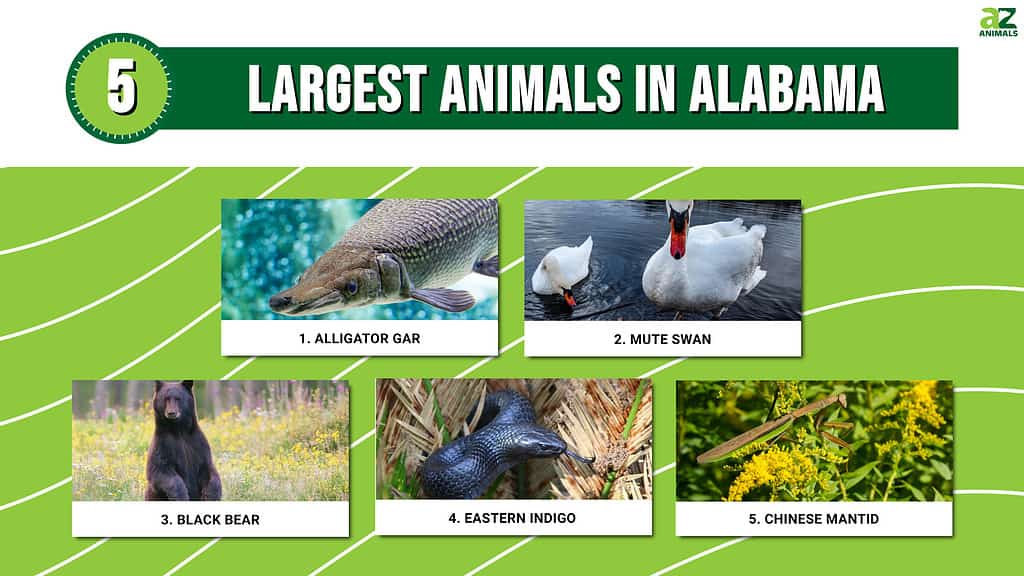
Alabama’s Largest Fish: Alligator Gar
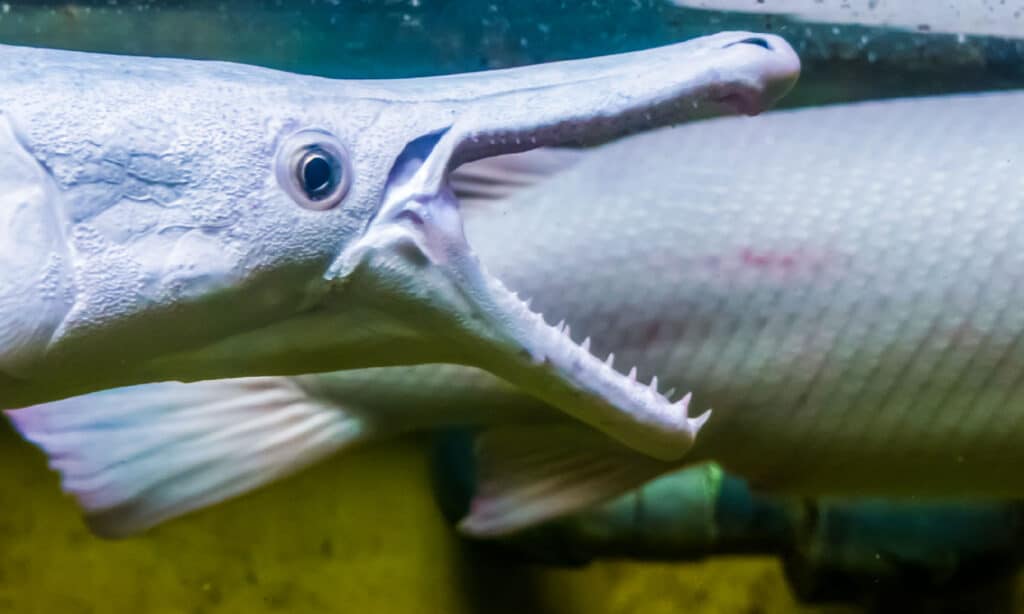
The largest alligator gar on record in Alabama weighed in at 162 pounds.
©Charlotte Bleijenberg/Shutterstock.com
The alligator gar is the largest fish that lives in Alabama. They are the largest of the gar species, growing up to 10 feet long and 350 pounds. In Alabama, the largest alligator gar on record weighed in at 162 pounds in January 2023. These massive fish are carnivores, feeding on fish, crabs, turtles, birds, and small mammals. They have few predators, with young alligator gars being at the most risk of being attacked and eaten. Despite their shared name, alligators have no relation to alligator gars and are one of their few predators.
These fish can be found in many parts of Alabama, mainly in the rivers and streams. They have also been found in brackish water and coastal estuaries, but they are known to prefer freshwater better.
Are Alligator Gars Dangerous?
With their massive size, you may be worried about them being dangerous in the water. Alligator gars pose almost no threat to humans, and there have been no known attacks. However, alligator gars produce eggs that are toxic to humans if ingested. Although a rare type of poisoning, it occurs most often when humans catch and cook the alligator gar without realizing it carries eggs. Many people are unaware of the danger of an alligator gar’s eggs.
Alligator gars were labeled as “trash fish” and not used for consumption for a long time. In recent years, this preconception has changed, and more people have started to eat them, unaware of the dangers that come with the consumption of their eggs. Luckily the toxicity of the eggs doesn’t seem to be too extreme in the few cases that have occurred. The toxin has been identified as a protein-based toxin known as ichthyotoxin, which causes vomiting and stomach upset for multiple days. Although these symptoms are certainly unpleasant, they aren’t known to be lethal. However, it’s best to be cautious if you choose to eat this fish and to ensure all eggs are removed as well as any skin that touches the eggs.
Alabama’s Largest Bird: Mute Swan
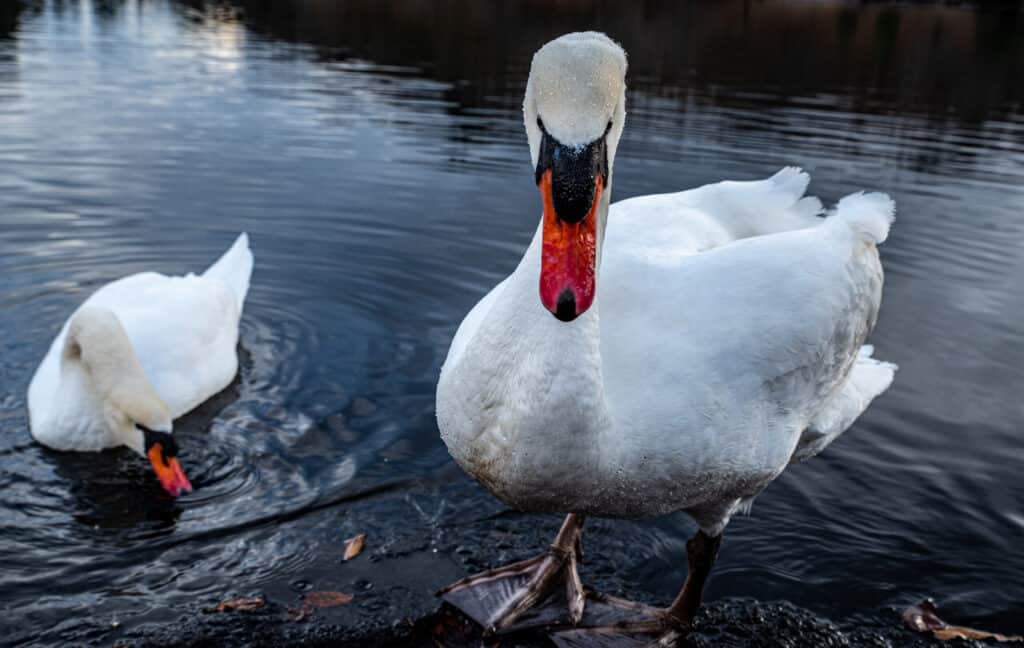
The mute swan is a non-native species brought to the state as ornamental birds to decorate the ponds and lakes.
©TETSU Snowdrop/Shutterstock.com
The largest bird in Alabama by weight is the mute swan, a non-native species that lives in many parts of the state. They are most commonly found in parks and floating on ponds. While true to their name as mute birds, their loudest sound is the beating of their wings. This whooshing noise is rumored to be heard half a mile away during take-off.
The swans were originally brought to the state as ornamental birds to decorate the ponds and lakes. However, they soon began reproducing and became a nuisance as they spread into the wild, taking over much of the native landscape and disrupting the natural ecosystem. They have spread so quickly due to their voracious eating and reproductive habits. They are very hardy birds who don’t migrate in the winter, so they continue expanding through reproduction once they are in an area. This has led to new efforts to remove the swans in an attempt to restore the native landscape.
Mute swans are large birds that can be aggressive. Weighing in at an average of 30 pounds, these big birds can be a minor threat to humans if approached. Because they are extremely defensive of their young, it is best to avoid the swans if you happen to come across one. They are fierce, with blood-drawing bites and wings rumored to break bones if one swipes at you. You are best to view and appreciate mute swans from a distance.
Alabama’s Largest Mammal: Black Bear
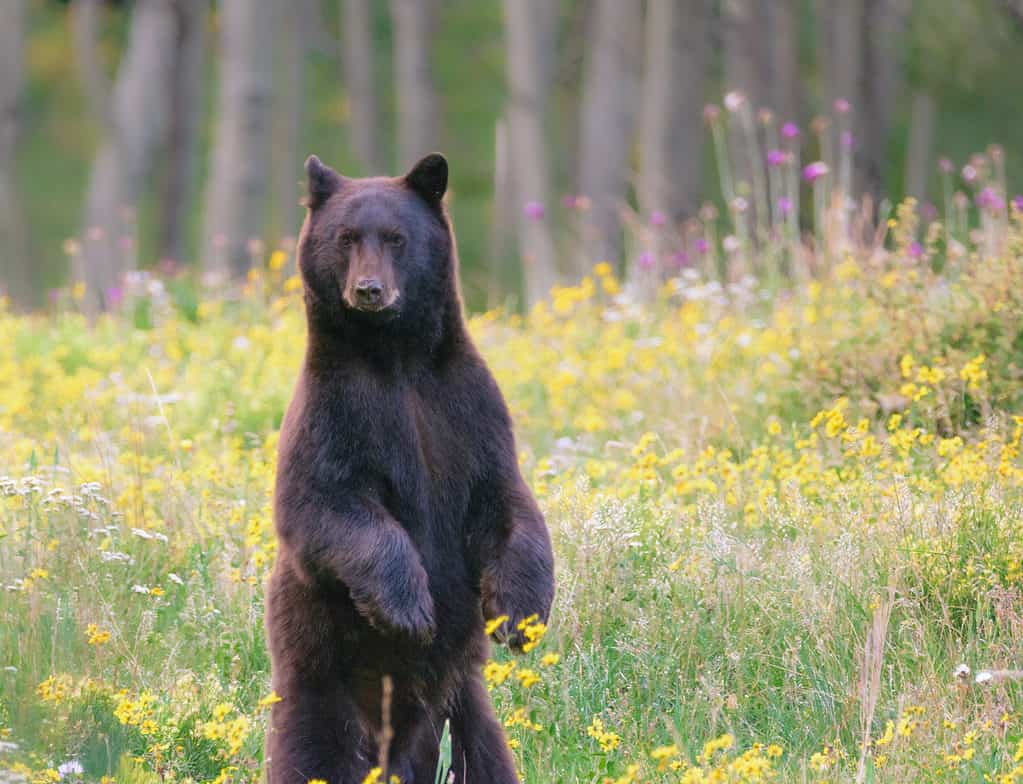
While black bears can grow to over 600 pounds, the biggest ever caught in Alabama was 308 pounds.
©Constance Mahoney/Shutterstock.com
The largest mammal in the state of Alabama is the black bear. Black bears can grow to over 600 pounds; however, the largest black bear ever caught in Alabama was 308 pounds. Historically, black bears were always found in south Alabama and were thought to have migrated up from Florida. These species are known as Ursus americanus floridanus, and are few in number. However, in recent years, another species of black bear has migrated westward from Georgia, Ursus americanus americanus, and spread into parts of north Alabama. You can see one of Alabama’s largest animals in wooded areas around Baldwin, Mobile, and Washington counties.
The black bear population is assumed to be increasing in Alabama, and there is currently no open season for black bears. The population should continue to increase in the future as long as humans and bears can coexist peacefully. Conservationists recommend keeping trash inside until trash day, feeding pets inside, and keeping cooking equipment inside. In doing so, confrontations between humans and bears can be limited.
Alabama’s Largest Snake: Eastern Indigo
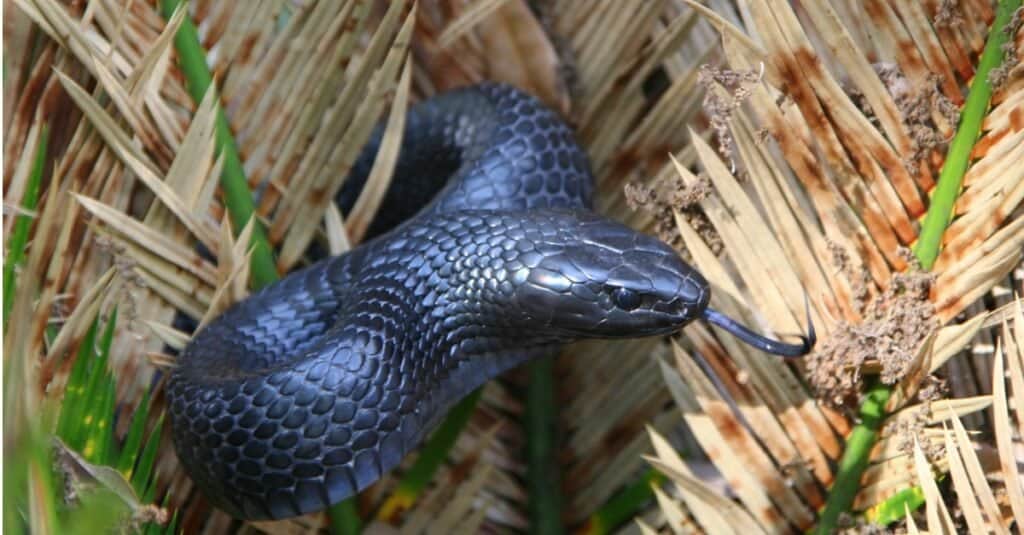
The eastern indigo snake is non-venomous and was previously extinct in Alabama.
©iStock.com/sstaton
The eastern indigo snake is the longest native snake species in America. It is a very large snake, growing up to eight feet long. It’s also a non-venomous snake, so there is no need to be wary if you spot one in the wild. In fact, this species of snake is quite favorable because they eat other poisonous species like rattlesnakes and cottonmouths. They also eat small mammals, birds, and even young alligators.
The eastern indigo is particularly special because it went extinct in Alabama in the 1950s. This was primarily due to habitat loss. Due to the loss of the native apex predator, the balance of other species was thrown off, so conservationists decided to make a change. Since 2006, their team has captured and bred wild eastern indigo snakes taken from Georgia. In 2010, they began releasing the offspring of these snakes into Conecuh National Forest in Alabama, with the goal of eventually introducing 300 eastern indigos back into their native environment.
In 2020, their efforts finally began to pay off as the first wild eastern indigo snake was discovered in the state. Then, in 2022, another one was found. All of the released snakes were given transponder tags, and these snakes did not have one, leading the experts to realize that they were indeed wild eastern indigos. Hopefully, in time, the population of these non-venomous apex predators will grow and spread throughout the entire state of Alabama, their native homeland.
Alabama’s Largest Insect: Chinese Mantid

The Chinese Mantid is an invasive species in North America and one of Alabama’s largest animals.
©Paul Reeves Photography/Shutterstock.com
Last but not least in our roundup of Alabama’s largest animals is the state’s largest insect: a non-native species known as the Chinese mantid or Tenodera aridifolia. This insect, a praying mantis, is native to Asia — including parts of Japan, India, and Indonesia. It was first introduced to America in 1896 in a Pennsylvania nursery by accident. Since then, the species has expanded into most of the eastern United States and California.
Unfortunately, the widespread presence of the Chinese mantid and its aggressive nature poses a threat to the native mantis species the Carolina mantid. Chinese mantids compete with native species for food, even consuming other mantids due to their cannibalistic nature.
The Chinese mantids grow to around 3 or 4 inches in length, making them the largest insect in the state of Alabama. They use their size to their advantage, allowing them to capture and eat other insects, frogs, and even small birds. The mantids are formidable predators, striking within one-twentieth of a second and able to turn their heads up to 180 degrees. They are found across all of Alabama but most commonly in places that are more humid. Chinese mantids prefer grasslands, woodlands, and areas near water. They often rest on a plant or tree, as they have great camouflage like many other mantis species.
Summary of 5 Largest Animals in Alabama, and Where You’ll Find Them
Here’s a recap of the five biggest animals found in Alabama that we looked at.
| Number | Category | Animal | Size | Range in Alabama |
|---|---|---|---|---|
| 1 | Largest Fish | Alligator Gar | Grow up to 10 feet long and 350 pounds | Found in many parts of Alabama, mainly in rivers and streams; also in brackish water and coastal estuaries |
| 2 | Largest Bird | Mute Swan | Weigh an average of 30 pounds | Parks and floating on ponds |
| 3 | Largest Mammal | Black Bear | Can grow to over 600 pounds | South Alabama; north Alabama in wooded areas around Baldwin, Mobile, and Washington counties |
| 4 | Largest Snake | Eastern Indigo | Grow up to 8 feet long | Conecuh National Forest |
| 5 | Largest Insect | Chinese Mantid | Grow to about 3-4 inches long | Across Alabama in humid grasslands, woodlands, and areas near water |
The photo featured at the top of this post is © TETSU Snowdrop/Shutterstock.com
Thank you for reading! Have some feedback for us? Contact the AZ Animals editorial team.






